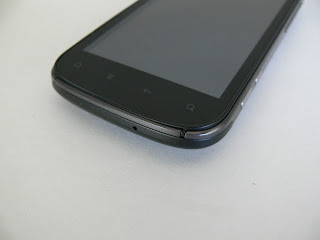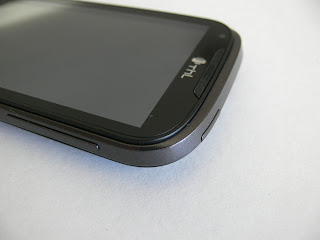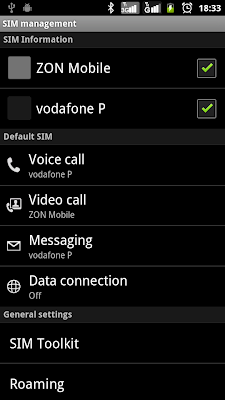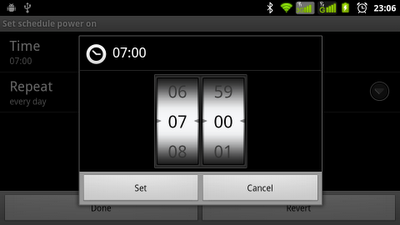If you have been following the latest news, then you should be already aware that MediaTek has released the new MT6575 chipset. The first engineering samples started to emerge by the end of the first quarter of this year and right now, the market is already filled up with quite a few interesting options.
I have decided to take ThL V9, not only for its appealing design, but also because the manufacturer is known for releasing phones with great quality and providing updates very often.
I have decided to take ThL V9, not only for its appealing design, but also because the manufacturer is known for releasing phones with great quality and providing updates very often.
Specifications
Chipset
Name: MediaTek MT6575 CPU: 1 GHz ARM Cortex™-A9 GPU: PowerVR™ SGX 531 Instruction set: ARMv7 Software environment
Embedded:OS: Android 2.3.6 (Gingerbread) Body
Dimensions
(width x height x depth):130 x 65.5 x 12.1 millimetres Weigth: 139 grams (battery included) Color: Black (also available in white or grey) Battery
Capacity: 1550 mAh Memory
RAM:capacity: 512 MB ROM-capacity: 4 GB Expansion slot: microSD memory card, supporting up to 32 GB Network support
Primary phone: GSM850, GSM900, GSM1800, GSM1900, UMTS850, UMTS2100 Secondary phone: GSM850, GSM900, GSM1800, GSM1900 Data links: GPRS, EDGE, HSDPA, HSUPA Display
Type: Sharp ASV-LCD capacitive touchscreen Size: 4.3 inches, qHD resolution (540 x 960 pixels) Camera
Main (rear): 5 megapixels with autofocus and dual LED flash Secondary (front): 0.3 megapixels Interfaces
Bluetooth (802.15): Bluetooth 3.0 + Enhanced Data Rate Wireless LAN / Wi-Fi (802.11): IEEE 802.11b, IEEE 802.11g, IEEE 802.11n USB: USB 2.0 Client, Hi-Speed (480 Mbit/s)
USB Series Micro-B (Micro-USB) connectorSatellite navigation
Built-in GPS module: MT6620 chipset GPS antenna: Internal Complementary GPS services: A-GPS (Assisted GPS), MediaTek EPO (Extended Prediction Orbit) Additional features
Sensors: Gravity, Proximity, Light and Magnetic field sensors Analog Radio: FM radio (87.5-108 MHz) with RDS radio receiver
This is actually one of the best well built Chinese smartphones that I've ever reviewed and a perfect clone of HTC Amaze 4G. Now that I was used to a 4" screen smartphone, of course I find it a bit larger (and a little bit heavier), but that's easily forgotten as soon as you start playing with it.
Rather than sink down into its bezel, its display actually rises slightly above it, giving the impression that it's coming out at you.
Rather than sink down into its bezel, its display actually rises slightly above it, giving the impression that it's coming out at you.
The 3,5 mm headset jack and dedicated power button are located on the top edge. The extra-large volume rocker is placed on the right edge.
The micro-USB port is located on the left edge. I usually prefer to have it at the top or bottom so that I can use the phone -while in charge- without having the cable get in the way.
On the right side of the device there are also shutter press and video record buttons for the camera.
On the back side, we find the 5 megapixels autofocus camera above a dual LED flash.
Display quality
Functionality
There are not that many changes related to the user interface, given that the stock ROM is still based on Android 2.3. Anyway, for those that haven't had any contact with a MT65x3 phone before, here are some screenshots and details of the most important features.
The notification panel provides a fast access for brightness and display timeout setting, enabling or disabling auto rotation, Wi-Fi, BT, GPS and data connection, as well as alternating between sound profiles.
The dialer interface has changed a little bit, although the features are exactly the same. It supports smart dialing feature (can be seen on the second picture) which works perfectly and very fast!
The notification panel provides a fast access for brightness and display timeout setting, enabling or disabling auto rotation, Wi-Fi, BT, GPS and data connection, as well as alternating between sound profiles.
The dialer interface has changed a little bit, although the features are exactly the same. It supports smart dialing feature (can be seen on the second picture) which works perfectly and very fast!
The dial button can immediately start the call when a SIM is set as default for voice calls or open a pop up which let's you choose from which SIM the call should be established.
In call history screen, the list of missed / received / made calls can be checked with the indication of the name of the SIM. In addition, you can filter calls by SIM.
Many options can be set under the dual SIM management menu. The user can edit the name of each SIM and also set the associated background color that will appear in call log as well as in the notification bar (behind the network strength bars).
In the same menu, the user has the possibility to set a default SIM card to establish all outgoing calls (both voice and video) or set it to always ask, thus enabling the pop up that I have referred above (with the options of which SIM card should initiate the call). The same thing can be set for messaging and data connection purposes.
The phone is equipped with proximity, light, gravity and magnetic field (compass) sensors.
The phone comes pre-installed with all Google applications, supporting e-mail, contact and calendar syncing. Google Play Store (formerly known as Android Market) works without any problem, providing access for free and paid applications / games.
Adobe Flash support was something that the owners of phones based on the previous MediaTek platform were missing (although there was a modified version for ARMv6 devices that worked more or less well). That is not a problem any more on the new platform, given that MT6575 already features an ARMv7 compliant processor.
Another weakness of the MT65x3 phones was the lack of NEON instruction set support, which didn't allowed Skype video calls (the user was limited to voice calls only). The processor used on the new MT6575 platform now supports it, so the users can enjoy Skype's video-calling feature. Personally, I have already tested it and I must say that it works flawlessly.
In terms of network reception, the phone performs greatly, having successfully passed all the tests that I've performed. Sound quality is clear enough and microphone quality is good.
Finally, but not less important, it must be mentioned that SIM2 will be reachable even if there is an active data connection established on SIM1. The data connection will be immediately dropped when a new call is incoming from SIM2 and the download will be automatically resumed after the call is over.
MT6575 chipset and benchmarks
MT6575 chipset features a single core 1 GHz ARM Cortex™-A9 processor and a PowerVR™ SGX531 graphical processor. The difference in terms of speed are easily noticed and the benchmarks prove it. Here you have the results of both ThL V9 and my good "old" G11i Pro (MT6575 versus MT6573).
The differences when compared to MT6573 (the device used for the benchmarks was G11i Pro) are pretty obvious: the benchmark score of ThL V9 is almost twice of G11i Pro (when overclocked to 800 MHz). For a more fair comparison, a friend of mine gently provided the score of his ZTE U960 (which is based on MSM8255 chipset):
I was pleasantly surprised to see that MediaTek MT6575 outperforms Qualcomm MSM8255, taking into account that both processors work at the same frequency -1 GHz. What a great job, MediaTek!
ThL V9 benchmark scores
G11i Pro benchmark scores
(overclocked CPU - 800 MHz)
(overclocked CPU - 800 MHz)
The differences when compared to MT6573 (the device used for the benchmarks was G11i Pro) are pretty obvious: the benchmark score of ThL V9 is almost twice of G11i Pro (when overclocked to 800 MHz). For a more fair comparison, a friend of mine gently provided the score of his ZTE U960 (which is based on MSM8255 chipset):
ZTE U960 benchmark scores
I was pleasantly surprised to see that MediaTek MT6575 outperforms Qualcomm MSM8255, taking into account that both processors work at the same frequency -1 GHz. What a great job, MediaTek!
Final thoughts
I'm really amazed with the performance of this phone. I only wished that I could have tested this phone already running Android 4.0 (there are rumours that a future update will be released given that other competitors are also working on it). Anyway, if you were looking for a fast and stable Dual SIM featuring 3G support, here's your chance.
Just let me finish this review with an advertisement... in order to avoid questions regarding where to buy it from, you can always visit my partner shop (etotalk.com). ThL V9 is available for 229 USD.
Just let me finish this review with an advertisement... in order to avoid questions regarding where to buy it from, you can always visit my partner shop (etotalk.com). ThL V9 is available for 229 USD.
Highs:
- High quality product
- Good battery life taking into consideration the big screen
- ARMv7 compliant processor (enabling native support for Adobe Flash and other applications)
Lows:
- Should have been released out-of-the-box with Android 4.0

































































0 comments:
Post a Comment